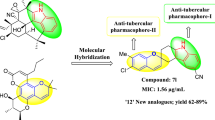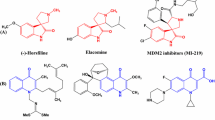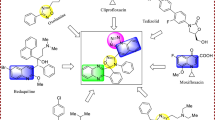Abstract
On the basis of reported antimycobacterial property of chroman-4-one pharmacophore, a series of chemically modified bis-spirochromanones were synthesized starting from 2-hydroxyacetophenone and 1,4-dioxaspiro[4.5] decan-8-one using a Kabbe condensation approach. The synthesized bis-spirochromanones were established based on their spectral data and X-ray crystal structure of 6e. All synthesized compounds were evaluated against Mycobacterium tuberculosis H37Rv (ATCC 27294) strain, finding that some products exhibited good antimycobacterial activity with minimum inhibitory concentration as low as \(3.125\, \upmu \hbox {g/mL}\). Docking studies were carried out to identify the binding interactions of compounds II, 6a and 6n with FtsZ. Compounds exhibiting good in vitro potency in the MTB MIC assay were further evaluated for toxicity using the HEK cell line.
Graphical Abstract














Similar content being viewed by others
References
World Health Organization (2016) Global tuberculosis report. Technical report from the World Health Organization, Geneva, Switzerland. http://www.who.int/mediacentre/factsheets/fs104/en/. Accessed 4 Mar 2017
Kaufmann SHE, Rubin E (2008) Handbook of tuberculosis: clinics, diagnostics, therapy and epidemiology. Wiley, Hoboken
Espinal MA (2003) The global situation of MDR-TB. Tuberculosis 83:44–51. doi:10.1016/S1472-9792(02)00058-6
Lienhardt C, Raviglione M, Spigelman M, Hafner R, Jaramillo E, Hoelscher M, Zumla A, Gheuens J (2012) New drugs for the treatment of tuberculosis: needs, challenges, promise, and prospects for the future. J Infect Dis 205:S241–S249. doi:10.1093/infdis/jis034
Bemer-Melchior P, Bryskier A, Drugeon HB (2000) Comparison of the in vitro activities of rifapentine and rifampicin against Mycobacterium tuberculosis complex. J Antimicrob Chemother 46:571–576. doi:10.1093/jac/46.4.571
Jain A, Mondal R (2008) Extensively drug-resistant tuberculosis: current challenges and threats. FEMS Immunol Med Microbiol 53:145–150. doi:10.1111/j.1574-695X.2008.00400.x
Fauci AS (2008) Multidrug-resistant and extensively drug-resistant tuberculosis: the national institute of allergy and infectious diseases research agenda and recommendations for priority research. J Infect Dis 197:1493–1498. doi:10.1086/587904
Barry CE, \(3{{\rm rd}}\), Blanchard JS, (2010) The chemical biology of new drugs in the development for tuberculosis. Curr Opin Chem Biol 14:456–466. doi:10.1016/j.cbpa.2010.04.008
Long R (2000) Drug-resistant tuberculosis. Can Med Assoc J 163:425–428
Lynch JB (2013) Multidrug-resistant tuberculosis. Med Clin N Am 97:553–579. doi:10.1016/j.mcna.2013.03.012
Kale MG, Raichurkar A, Waterson D, McKinney D, Manjunatha M, Kranthi U, Koushik K, Jena LK, Shinde V, Rudrapatna SJ (2013) Thiazolopyridine ureas as novel antitubercular agents acting through inhibition of DNA gyrase B. J Med Chem 56:8834–8848. doi:10.1021/jm401268f
Scorpio A, Zhang Y (1996) Mutations in pncA, a gene encoding pyrazinamidase/ nicotinamidase, cause resistance to the antituberculous drug pyrazinamide in tubercle bacillus. Nat Med 2:662–667. doi:10.1038/nm0696-662
Sharma K, Chopra P, Singh Y (2004) Recent advances towards identification of new drug targets for Mycobacterium tuberculosis. Expert Opin Ther Targets 8:79–93. doi:10.1517/14728222.8.2.79
Virsdoia V, Shaikh MS, Manvar A, Desai B, Parecha A, Loriya R, Dholariya K, Patel G, Vora V, Upadhyay K, Denish K, Shah A, Coutinho EC (2010) Screening for in vitro antimycobacterial activity and three-dimensional quantitative structure-activity relationship (3D-QSAR) study of 4-(arylamino)coumarin derivatives. Chem Biol Drug Des 76:412–424. doi:10.1111/j.1747-0285.2010.00997.x
Manvar A, Bavishi A, Radadiya A, Patel J, Vora V, Dodia N, Rawal K, Shah A (2011) Diversity oriented design of various hydrazides and their in vitro evaluation against Mycobacterium tuberculosis H37Rv strains. Bioorg Med Chem Lett 21:4728–4731. doi:10.1016/j.bmcl.2011.06.074
Tietze LF, Bell HP, Chandrasekhar S (2003) Natural product hybrids as new leads for drug discovery. Angew Chem Int Ed 42:3996–4028. doi:10.1002/anie.200200553
Deady LW, Desneves J, Kaye AJ, Finlay GJ, Baguley BC, Denny WA (2008) Synthesis and antitumor activity of some indeno[\(1,2-b\)]quinoline-based bis carboxamides. Bioorg Med Chem 8:977–984. doi:10.1016/S0968-0896(00)00039-0
Feng S, Wang Z, He X, Zheng S, Xia Y, Jiang H, Tang X, Bai D (2005) Bis-huperzine B:? highly potent and selective acetylcholinesterase inhibitors. J Med Chem 48:655–657. doi:10.1021/jm0496178
Feng L, Maddox MM, Zahidul-Alam Md, Tsutsumi LS, Narula G, Bruhn DF, Wu X, Sandhaus S, Lee RB, Simmons CJ, Dinh YCT, Hurdle JG, Lee RE, Sun D (2014) Synthesis, structure-activity relationship studies, and antibacterial evaluation of 4-chromanones and chalcones, as well as olympicin A and derivatives. J Med Chem 57:8398–8420. doi:10.1021/jm500853v
Mujahid M, Gonnade RG, Yogeeswari P, Sriram D, Muthukrishnan M (2013) Synthesis and antitubercular activity of amino alcohol fused spirochromone conjugates. Bioorg Med Chem Lett 23:1416–1419. doi:10.1016/j.bmcl.2012.12.073
Wu MC, Peng CF, Chen IH, Tsai IL (2011) Antitubercular chromones and flavonoids from pisonia aculeata. J Nat Prod 74:976–982. doi:10.1021/np1008575
Kabbe HJ (1982) Synthesis and reactions of 4-chromanones. Angew Chem Int Ed Engl 21:247–256. doi:10.1002/anie.198202471
Kabbe HJ (1978) Eine einfache synthese von 4-chromanonen. Synthesis 886–887: doi:10.1055/s-1978-24924
Dolle RE, Bourdonnec BL, Chu GH (2009) Spirocyclic heterocyclic derivatives and methods of their use. Patent US 7598261
Dillard LW, Yuan J, Jia L, Zheng Y (2010) Inhibitors of beta-secretase. PCT Int, Appl, p 2010021680
Melak T, Sunita G (2015) Maximum flow approach to prioritize potential drug targets of Mycobacterium tuberculosis H37Rv from protein-protein interaction network. Clin Trans Med 4:1–10. doi:10.1186/s40169-015-0061-6
Erickson HP (1995) FtsZ, a prokaryotic homolog of tubulin. Cell 80:367–370. doi:10.1016/0092-8674(95)90486-7
Addinall SG, Holland B (2002) The tubulin ancester, FtsZ, draughtsman, designer and driving force for bacterial cytokinesis. J Mol Biol 318:219–236. doi:10.1016/S0022-2836(02)00024-4
Erickson HP (1997) FtsZ, a tubulin homologue in prokaryote cell division. Trends Cell Biol 7:362–367. doi:10.1016/S0962-8924(97)01108-2
Margolin W (2000) Themes and variations in prokaryotic cell division. FEMS Microbiol Rev 24:531–548. doi:10.1111/j.1574-6976.2000.tb00554.x
Bi E, Lutkenhaus J (1991) FtsZ ring structure associated with division in Escherichia coli. Nature 354:161–164. doi:10.1038/354161a0
Oliva MA, Cordell SC, Lowe J (2004) Structural insights into FtsZ protofilament formation. Nat Struct Mol Biol 11:1243–1250. doi:10.1038/nsmb855
Adams DW, Errington J (2009) Bacterial cell division: assembly, maintenance and disassembly of the Z ring. Nat Rev Microbiol 7:642–653. doi:10.1038/nrmicro2198
Margolin W (2005) FtsZ and the division of prokaryotic cells and organelles. Nat Rev Mol Cell Biol 6:862–871. doi:10.1038/nrm1745
Payne DJ, Gwynn MN, Holmes DJ, Pompliano DL (2007) Drugs for bad bugs: confronting the challenges of antibacterial discovery. Nat Rev Drug Discov 6:29–40. doi:10.1038/nrd2201
Lock RL, Harry EJ (2008) Cell-division inhibitors: new insights for future antibiotics. Nat Rev Drug Discov 7:324–338. doi:10.1038/nrd2510
Gerlier D, Thomasset N (1986) Use of MTT colorimetric assay to measure cell activation. Immunol Methods 94:57–63. doi:10.1016/0022-1759(86)90215-2
Schrodinger Suite (2011) Induced fit docking protocol, Glide, version 5.6, LLC, New York. https://www.schrodinger.com/newsletters/extra-precision-xp-docking-and-scoring-overview
Li Y, Hsin J, Zhao L, Cheng Y, Shang W, Huang KC, Wang HW, Ye S (2013) FtsZ protofilaments use a hinge-opening mechanism for constrictive force generation. Science 341:392–395. doi:10.1126/science.1239248
Berman HM, Westbrook J, Feng Z, Gilliland G, Bhat TN, Weissig H, Shindyalov IN, Bourne PE (2000) The protein data bank. Nucleic Acids Res 28:235–242
Acknowledgements
The authors thank The Head, Department of Chemistry, Osmania University, Hyderabad, for providing laboratory facilities. A.V.K. thanks CSIR for Ph.D. fellowship. B.S.K. thanks Schrödinger Suite 2011, Glide5.6 software, LLC. We thank CFRD analytical team for providing spectral analysis facilities.
Author information
Authors and Affiliations
Corresponding author
Electronic supplementary material
Below is the link to the electronic supplementary material.
Rights and permissions
About this article
Cite this article
Dongamanti, A., Aamate, V.K., Devulapally, M.G. et al. Bis-spirochromanones as potent inhibitors of Mycobacterium tuberculosis: synthesis and biological evaluation. Mol Divers 21, 999–1010 (2017). https://doi.org/10.1007/s11030-017-9779-y
Received:
Accepted:
Published:
Issue Date:
DOI: https://doi.org/10.1007/s11030-017-9779-y




